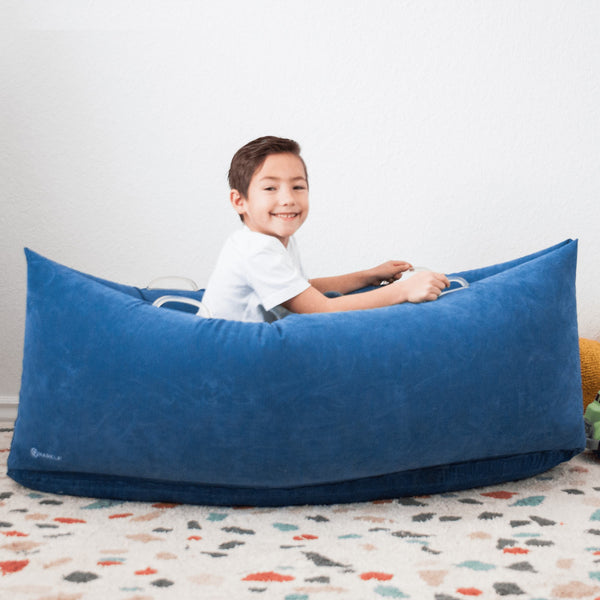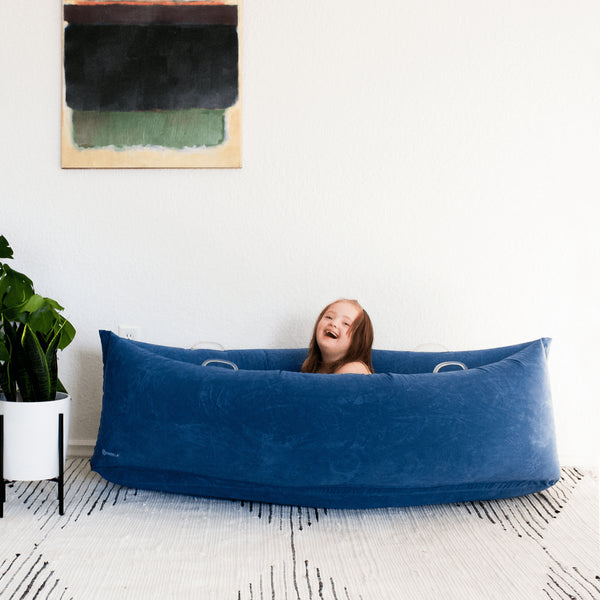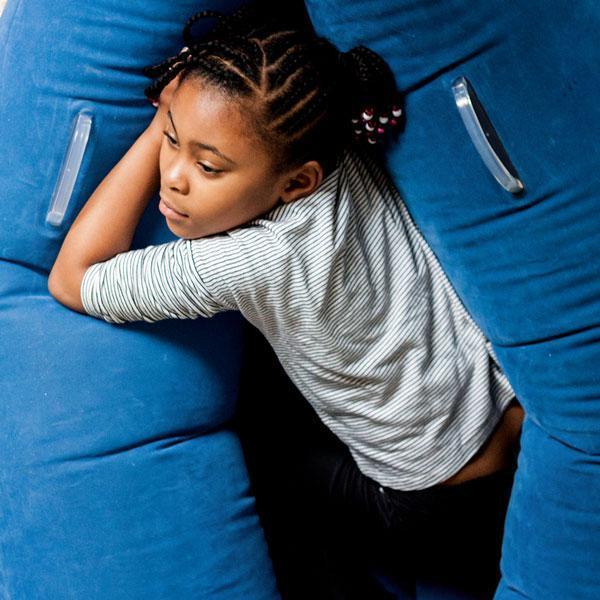MATERIALS:
Exterior: 100% Soft Flocked Vinyl
MEASUREMENTS:
Small: 48 x 29 x 20 inches
Medium: 60 x 29 x 20 inches
RECOMMENDED LIMITS & USES:
Small: Ages 2-6 | Maximum Weight 50lbs
Medium: Ages 6-12 | Maximum Weight 100lbs
WHAT'S INCLUDED:
The Harkla Hug
Electric Pump
Patch Kit
The Harkla Hug combines a sensory input tool with the fun of a toy!
Inflate the sensory pea pod and watch your child explore a new comfort spot in your home or kid's sensory room. Now made with flocked vinyl, this durable peapod sensory chair is a perfect addition.
The Harkla Hug is a family favorite for those with autism, sensory challenges, and ADHD!
The inflatable peapod for autism applies much-needed pressure to sensitive areas of the body helping your child feel grounded and in control. This cozy canoe is perfect for autism. It stirs a sense of adventure while the compression provides a calming comfort where your child can feel secure. Use this sensory processing disorder tool to add comfort and joy in your child’s life.
The Harkla Hug provides deep touch pressure (DTP) in the form of firm tactile sensory input or proprioceptive input to the whole body. When administered to the whole body, deep touch pressure therapy (DTP) has a calming, organizing effect on children and adults alike.
We think children with special needs should have every opportunity to live happy and healthy lives. That's why Harkla is dedicated to providing families with the best products and resources for raising a special needs child. Read more of our story here.
Is There A Height Or Weight Limit For The Harkla Hug?
We've found the small (48 x 29 x 20 inches) to be best for those between the ages of 2-6 and recommend a weight maximum of 50 lbs.
The large (60 x 29 x 20 inches) is best for kids between ages 6-12 and should be 100 lbs or less.
Does The Harkla Hug Come With An Inflation Device?
Yes! We will send you an electric pump that makes it super fast and easy to inflate the pea pod seat.
What Happens If The Harkla Hug Gets Damaged From Use?
Things happen! That's why Harkla sends you a patch kit for unexpected damage. We also maintain our product lifetime guarantee for the Harkla Hug. Unless you are 100% satisfied, we aren’t satisfied either. We're a company that truly cares about you and will answer any questions or concerns you have.
Once you get your product, simply visit harkla.co/warranty to register your warranty.
Where Do We Ship This Product?
From the Harkla Website, we only ship this product to the United States.
However, if you are looking for us in another country, we have options for purchasing!
Canada: Shop our store on Amazon Canada
Australia: Shop for us with our Australian Partner Starfish
If you're looking for another country, please check out our partner page to see if our products are available in your country through another retailer!
If you’d like to be informed of when we will be shipping to your country, please contact our customer service: support@harkla.co
What is the Harkla hug?
The Harkla hug is an inflatable peapod sensory chair - the perfect cozy canoe that provides calming compression along with a soft flocked vinyl feel. Providing deep touch pressure (DTP) with firm tactile and proprioceptive input, the Hug is a great addition to any sensory corner or play area.
Who can benefit from the Harkla hug?
Well, really, ANYONE and EVERYONE!
But let’s get more specific. The Hug was created with sensory in mind - meaning children who struggle with sensory processing are the main beneficiaries of the Harkla Hug sensory peapod.
Let’s break it down a bit more.
Improving Attention:
Here is a child who is struggling with sustained attention to a task - specifically a sit-down task that requires focus for five + minutes. This child is unable to maintain attention to complete the task, is fidgeting constantly, is getting up and moving around the room, and/or is too distracted by surrounding noises and visual stimuli. This child may benefit from incorporating the Hug into the sit-down task or using it before the task to help organize their sensory system to prepare to focus!
Struggling with Anxiety:
How about a child who struggles with anxiety, specifically, anxiety during transitions, while in large crowded areas, or when trying something new? This child may become fearful, cry or refuse to leave, refuse to participate, and exhibit physical symptoms of anxiety such as nausea or headaches. Incorporating the Hug into the daily routine and playtime can provide calming proprioceptive input to help a child struggling with anxiety!
Improving Bedtime:
Let’s look at a child struggling with bedtime - specifically falling asleep, which includes getting into bed and staying in bed. This child may crawl into bed at bedtime, but then they toss and turn, cannot get comfortable, refuse to close their eyes, and get up out of bed several times. They may also exhibit signs of anxiety or hyperactivity, despite the late hour. This child may benefit from using the Hug before bedtime, as part of the bedtime routine, to provide calming DTP to help calm the sensory system to prepare for sleep!
If a child has a diagnosis or signs/symptoms of ADHD/ADD, Autism, Down Syndrome, Developmental Delay, cognitive/learning challenges, Apraxia, SPD, or speech/language delay, the Hug can be a great addition to their play and development.
Different types of sensory input
The Harkla hug provides two main sensory inputs: proprioception and tactile.
Proprioception
Proprioception is the awareness of the position and movement of the body. Sensory receptors are located on your skin, joints, and muscles. When we move, these sensory receptors send signals to our brain, telling it about the movement's effort, force, and heaviness. Then our body can provide an appropriate response.
When we think about proprioceptive movement, we can also include heavy work - any movement that works the muscles, deep pressure - any input that provides pressure to our body, and vibration. Proprioceptive input is typically calming to the nervous system.
Individuals are usually not over-responsive to proprioception, meaning they don't have over-reactions to this type of sensory input. We do, however, see individuals who are under-responsive or sensory craving, meaning they want more heavy work, crashing, hugs, etc.
The Hug provides proprioceptive input through compression - almost like an actual hug!
Tactile
Tactile input is received through our skin. It includes light touch, firm touch, and the discrimination of different textures, including dry to wet and messy. The tactile system is also responsible for the processing of pain and temperature. Tactile input can be alerting, calming, or over-stimulating, depending on the person.
The Hug provides tactile input that can be calming due to the soft material. It gives immediate feedback to the tactile and proprioceptive systems - as mentioned above, DTP!
Another Added Benefit
Another area that the Hug adds to is body awareness and spatial relations. When we complete an activity that provides both proprioception and tactile input, our ability to understand our body in space better and within our environment improves. This has the added benefit of improving safety, coordination, and motor planning!
Tips For Introducing The Harkla Hug to Your Child
Some children LOVE the Hug immediately - these children love to move and explore. Typically, these children do not need a “formal” introduction to the Hug.
However, some children are more hesitant when using the Hug - these children may have challenges processing and modulating vestibular, proprioceptive, and/or tactile input. These children may refuse to climb into the Hug, may not know how to climb in or use the Hug, etc.
If your child is unsure about the Hug, try these tips to engage them:
- Include your child in the process of blowing the Hug up!
- Model! Get in the Hug and show your child how to climb in and out. Let your child watch you have fun in the Hug. Allow your child to help you.
- Place favorite toys in the Hug and allow your child to pull their toys around.
- Use the Hug on a soft surface such as cushions to decrease falling out on a hard surface.
- Allow your child to choose how to interact with the Hug. Allow them time to explore.
- Never force your child to get in the Hug unwillingly. It will take them longer in the long run if we push them!
- Avoid pressuring your child to get in the Hug as well. This includes positive pressure (i.e. “If you get in the hug, you can have a piece of chocolate!”). Leave it out, let them explore, walk away (if safe) and when they get in on their own, don’t make a big deal about it! Just talk to them calmly about how it feels, what they think, etc.
Tips for Incorporating the Harkla Hug into Your Child’s Day
Incorporating the Hug into your child’s daily routine can help with self-regulation throughout the day and add a playful element into the day. Here are some tips for incorporating the Hug into your child’s routine:
- Add the Hug to the morning routine to help “wake up.”
- Add the Hug to the bedtime routine to help “calm down.”
- Use the Hug as a “brain break” in between school/homework.
- Offer the Hug after school, before getting started on homework, chores, or extracurricular activities to reset the nervous system.
- Use the Hug as part of a sensory diet to help with arousal level.
- Allow your child to use the hug independently in order to de-stress or calm down when upset.

























